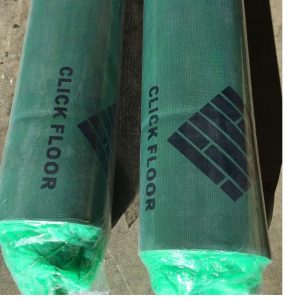Underlayments are generally sold in rolls of 100s/f. Prices range from $25 to $80 per roll, translating to an extra $0.25 to $0.80 to your flooring cost. Often, homeowners reduce the overall total cost of their flooring purchase by purchasing a cheap underlayment. This is not a good idea.
Underlayments are an important aspect of laminate floors for two primary reasons. Firstly the quality of your underlayment has a direct effect on how the floor feels and sounds underfoot. Secondly, the underlayment will affect the wear and tear of your floor.
Underlayments server the following purposes:
Moisture protection
Thermal insulation
Impact sound absorption
Hinders mould growth with anti-microbial additive
Help prevent dust mite colonies
Smooth minor subfloor imperfections

Impact sound absorption:
The main factors that affect the sound are the thickness and density of the underlayment. Underlayments range from 0.075in to 0.25in in thickness. Because laminate flooring is a floating floor, i.e. it is not fixed to the sub-floor, the floor tends to give off the sound when walked upon. Thicker underlayments offer more sound reduction.
Additionally, denser underlayments also reduce sound as well as offering more stability. However, thick underlayments with low density can add instability to the floor as they are compressed when walked upon, and this will be felt underfoot. In particular, natural cork underlayments are very good sound insulators, as well as being very dense. If you live in an apartment and people are living below you, sound absorption is a very important factor. If you do not install a sufficient sound barrier, your neighbours will hear you walking on the floor, and this could result in you having to remove your new floor.
Thermal Insulation:
If you live in a cold climate, thermal insulation is an important factor. Thicker underlayments act as better heat insulators and barriers. Radiant heat panel underlayments are also available.
Moisture protection:
Moisture rising from a damp subfloor will slowly destroy the core of your laminate flooring. To combat this, your underlayment should have some form of vapour barrier to protect the underneath of the floor from subfloor moisture. Some underlayments are an all-in-one sound and moisture solutions, while others are either sound or moisture barriers. Regardless of what type of sub-floor you have, installing a moisture barrier is essential.
Hinder Mold Growth with Anti-Microbial Additive and prevent dust mite colonies:
If you live in a climate where mould growth is common, you can install an underlayment with an anti-microbial additive. If your sub-floor is wood, this type of underlayment can also prevent dust mite colonies.
Smooth minor subfloor imperfections:
Generally speaking, laminate floors can only be installed over level sub-floors. If your floor has minor undulations, a thick, dense underlayment can help to smooth out the undulations. Note that this is only for minor undulations. Floors with serious undulations must be levelled before installing a laminate floor.
